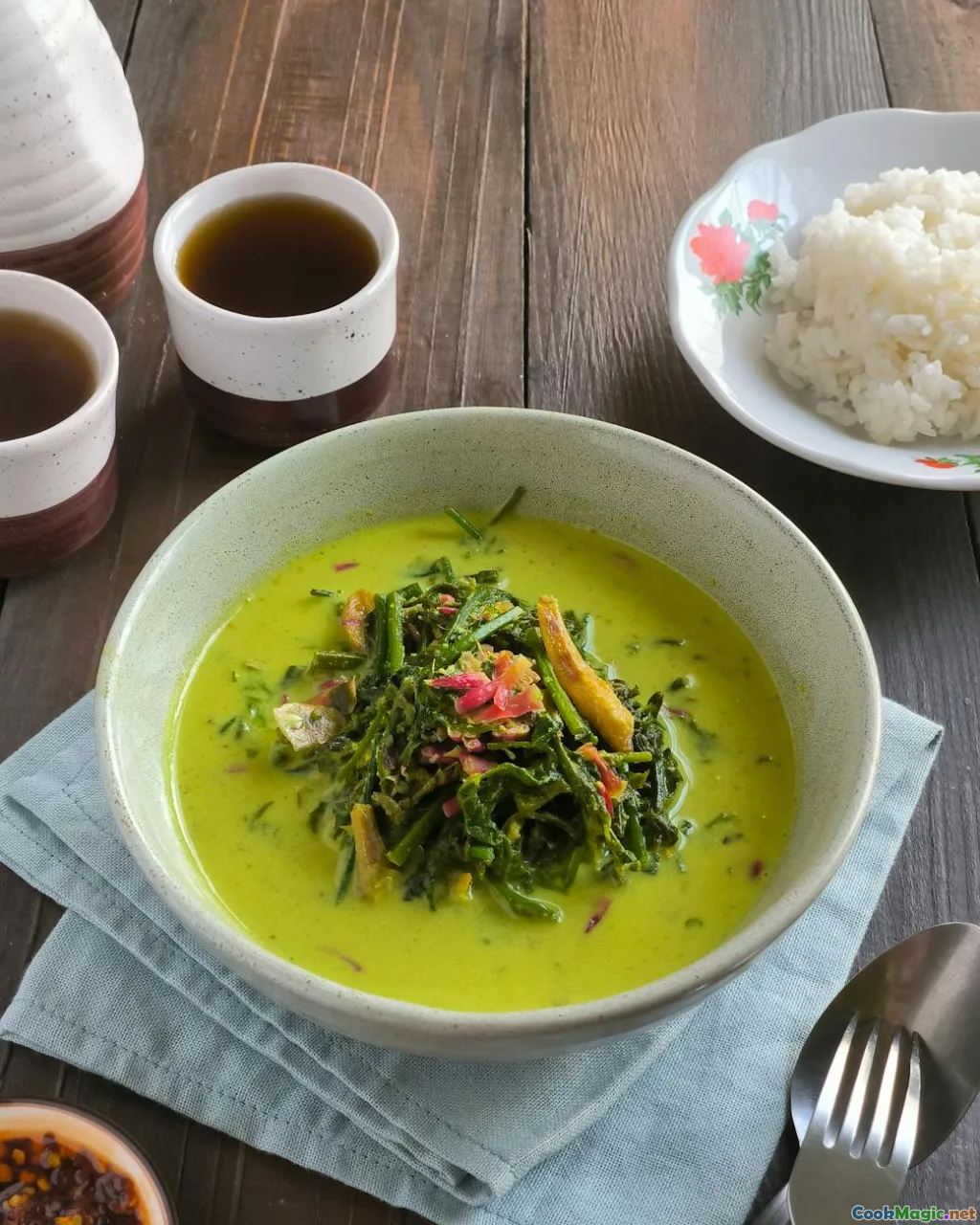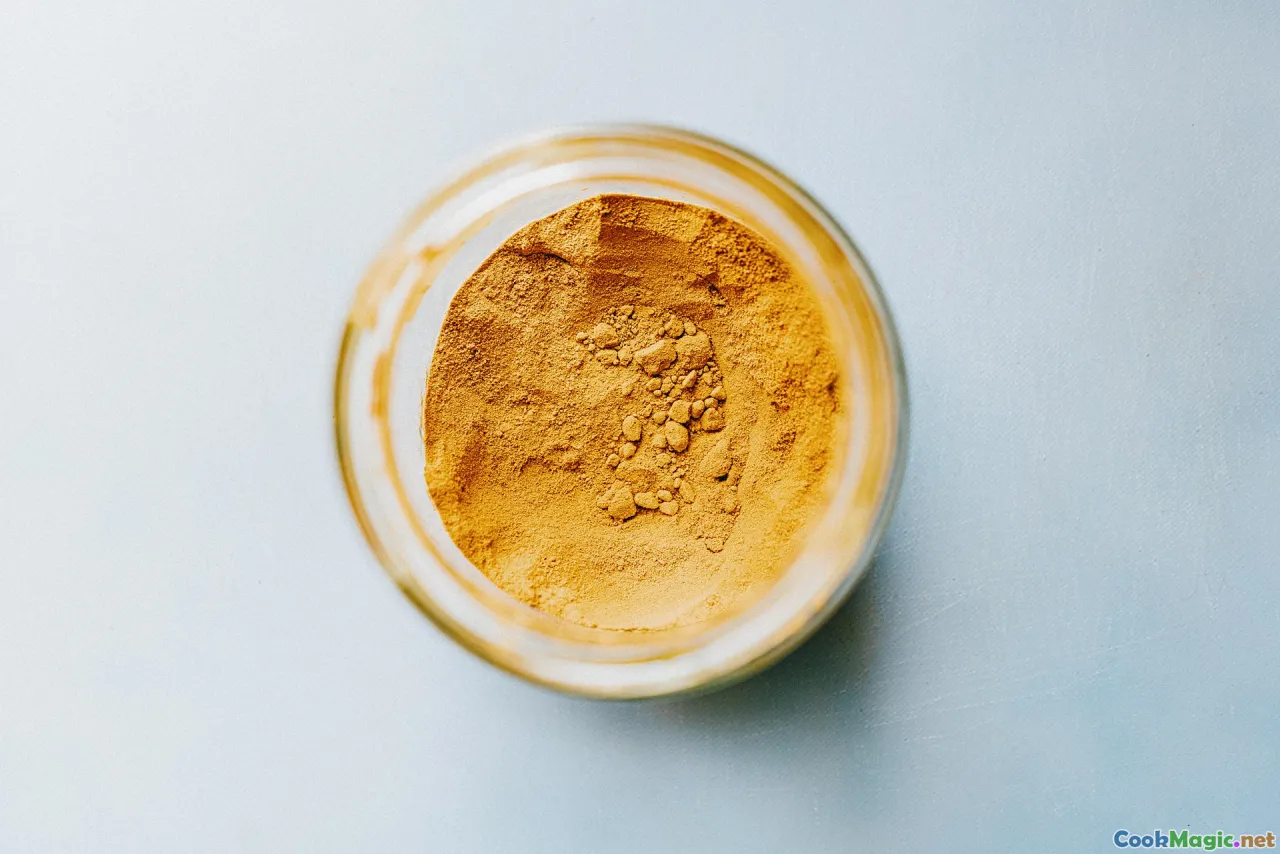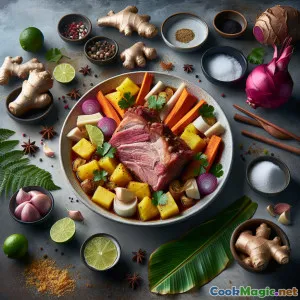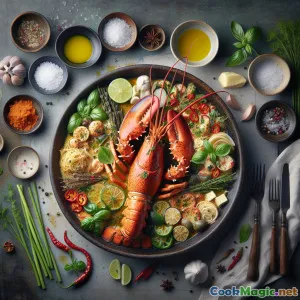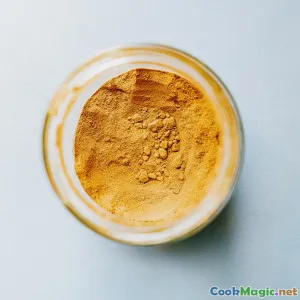
Kokopo zencefil-zerdeçallı yengeç köri
(Kokopo Ginger Turmeric Crab Curry)
(0 Yorumlar)0
319
Ekim 31, 2025
Bir Sorun Bildir
Malzemeler
-
1200 grams Canlı çamur yengeci (veya mavi yüzücü yengeci)
(Cleaned and cut into 6–8 pieces)
-
2 tbsp Hindistancevizi yağı
(Ya nötr yağ)
-
1 piece Kahverengi soğan
(İnce doğranmış)
-
4 cloves Sarımsak dişleri
(İnce doğranmış)
-
30 grams Taze zencefil
(Soyulmuş ve rendelenmiş)
-
20 grams Taze zerdeçal
(Peeled and grated; or 2 tsp ground turmeric)
-
2 pieces Kuş gözü biberi
(Sliced; adjust to taste)
-
1 stalk Limonotu gövdesi
(Bruised to release oils)
-
4 leaves Kaffir limonu yaprakları
(Kokusu serbest bırakmak için kopar)
-
8 leaves Köri yaprakları
(Mümkünse taze)
-
1 tsp Toz Kişniş
(Bloom with oil for best flavor)
-
1 tsp Toz kimyon
(Bloom with oil for best flavor)
-
0.5 tsp Taze çekilmiş karabiber
(Tadı ayarlayın)
-
1 tsp Deniz tuzu
(Plus more to taste)
-
400 ml Hindistan cevizi sütü
(Full-fat for richness)
-
250 ml Balık suyu (veya su)
(Adjust thickness as desired)
-
1 piece Domates
(Large, diced)
-
1 tsp Hindistancevizi şekeri
(Kahverengi şeker veya esmer şeker)
-
1 tbsp Balık sosu
(For depth and umami)
-
2 tbsp Limon suyu
(Taze sıkılmış)
-
10 grams Taze kişniş (kekik) yaprakları
(Kaba doğranmış, süsleme için)
-
4 bowls Buharda pişirilmiş yasemin pirinci
(Servis için)
(Cleaned and cut into 6–8 pieces)
(Ya nötr yağ)
(İnce doğranmış)
(İnce doğranmış)
(Soyulmuş ve rendelenmiş)
(Peeled and grated; or 2 tsp ground turmeric)
(Sliced; adjust to taste)
(Bruised to release oils)
(Kokusu serbest bırakmak için kopar)
(Mümkünse taze)
(Bloom with oil for best flavor)
(Bloom with oil for best flavor)
(Tadı ayarlayın)
(Plus more to taste)
(Full-fat for richness)
(Adjust thickness as desired)
(Large, diced)
(Kahverengi şeker veya esmer şeker)
(For depth and umami)
(Taze sıkılmış)
(Kaba doğranmış, süsleme için)
(Servis için)
Besin Değerleri
- Porsiyon: 4
- Porsiyon Boyutu: 1 kase (350g)
- Calories: 480 kcal
- Carbohydrates: 0 g
- Protein: 39 g
- Fat: 30 g
- Fiber: 3 g
- Sugar: 6 g
- Sodium: 980 mg
- Cholesterol: 180 mg
- Calcium: 120 mg
- Iron: 4.2 mg
Talimatlar
-
1 - Prepare and clean the crab:
Dispatch crab humanely and clean under cold running water. Remove gills and sandbag. Crack large claws with the back of a knife. Cut the body into 4–6 pieces; drain well.
-
2 - Make the ginger–turmeric paste:
Pound ginger, turmeric, garlic, and chilies in a mortar and pestle to a coarse paste (or pulse in a processor). This paste is the curry’s aromatic backbone.
-
3 - Bloom spices and sauté aromatics:
Heat coconut oil in a wide pot over medium heat. Add onion; cook until translucent. Stir in coriander, cumin, and black pepper; toast 30 seconds. Add the paste; cook until fragrant.
-
4 - Build the curry base:
Add lemongrass, kaffir lime leaves, and curry leaves. Stir in tomato. Pour in coconut milk and fish stock; bring just to a gentle simmer, avoiding a rolling boil to prevent splitting.
-
5 - Simmer the crab:
Add crab pieces and salt. Cover and simmer, turning once, until shells are bright and meat is opaque and springy, about 10–12 minutes depending on size.
-
6 - Season and balance:
Remove lid; add fish sauce and palm sugar. Simmer 2 minutes to meld flavors. Stir in lime juice; taste and adjust salt, sugar, or acidity as needed.
-
7 - Rest and Garnish:
Remove lemongrass and lime leaves. Let curry rest off-heat 2–3 minutes. Garnish with chopped coriander leaves.
-
8 - Serve island-style:
Ladle curry and crab into warm bowls. Serve with steamed jasmine rice. Provide crab crackers and finger bowls for easy, joyful eating.
Dispatch crab humanely and clean under cold running water. Remove gills and sandbag. Crack large claws with the back of a knife. Cut the body into 4–6 pieces; drain well.
Pound ginger, turmeric, garlic, and chilies in a mortar and pestle to a coarse paste (or pulse in a processor). This paste is the curry’s aromatic backbone.
Heat coconut oil in a wide pot over medium heat. Add onion; cook until translucent. Stir in coriander, cumin, and black pepper; toast 30 seconds. Add the paste; cook until fragrant.
Add lemongrass, kaffir lime leaves, and curry leaves. Stir in tomato. Pour in coconut milk and fish stock; bring just to a gentle simmer, avoiding a rolling boil to prevent splitting.
Add crab pieces and salt. Cover and simmer, turning once, until shells are bright and meat is opaque and springy, about 10–12 minutes depending on size.
Remove lid; add fish sauce and palm sugar. Simmer 2 minutes to meld flavors. Stir in lime juice; taste and adjust salt, sugar, or acidity as needed.
Remove lemongrass and lime leaves. Let curry rest off-heat 2–3 minutes. Garnish with chopped coriander leaves.
Ladle curry and crab into warm bowls. Serve with steamed jasmine rice. Provide crab crackers and finger bowls for easy, joyful eating.
Kokopo zencefil-zerdeçallı yengeç köri :Hakkında Daha Fazlası
Why this curry is special
Kokopo Ginger Turmeric Crab Curry celebrates the coastal abundance of East New Britain in Papua New Guinea. The markets of Kokopo brim with live mud crab, fragrant stalks of lemongrass, and knobbly roots of ginger and turmeric grown in mineral-rich volcanic soils. This dish captures that vivid terroir in a single bowl: sunny turmeric color, peppery ginger glow, and the gentle sweetness of coconut milk embracing sweet crab meat.
Rather than relying on heavy spice blends, this curry showcases a short, bright list of aromatics. Fresh turmeric and ginger form the radiant core, supported by lemongrass and kaffir lime leaves for a green, citrusy lift. It is a curry that prioritizes freshness and balance over heat or complexity—easy to love and surprisingly straightforward to make.
Technique notes for perfect results
- Build a paste, not a puree: Pounding ginger, turmeric, garlic, and chili by hand gives texture and releases oils more gently than a blender. If using a processor, pulse just until coarse.
- Bloom spices briefly: Toasting ground coriander and cumin in oil for 30–45 seconds wakes them up. Go too long and they turn bitter; too short and they taste raw.
- Protect the coconut milk: Keep the pot at a gentle simmer. A vigorous boil can cause the coconut fat to split. If the texture looks oily, reduce the heat and stir in a splash of stock.
- Cook crab by feel: Crab is done when the shells turn bright and the meat is opaque and springy. Overcooked crab becomes stringy and dry. Size matters—large mud crab pieces need the full 12 minutes; smaller swimmers cook faster.
- Balance at the end: Palm sugar, fish sauce, and lime juice are your three-point balance—sweetness, salinity/umami, and acidity. Adjust until the curry tastes round and lively.
Sourcing and smart substitutions
- Crab: Mud crab is traditional and meaty. Blue swimmer crab offers a delicate sweetness. In a pinch, use high-quality frozen raw crab pieces. Avoid pre-cooked crab; it won’t absorb the curry flavors.
- Turmeric: Fresh is ideal for color and perfume. If using ground, start at 2 teaspoons and adjust. Handle fresh turmeric with care—its pigment can stain cutting boards and hands.
- Aromatics: Kaffir lime leaves and curry leaves add a wonderful high note but are optional. If unavailable, add extra lime zest and a few basil leaves at the end.
- Stock: Fish stock deepens the base; water works if you season carefully. Do not use overly salty stocks—remember fish sauce arrives later.
Serving ideas and pairings
- Rice is classic, but sago pearls, taro, or boiled cassava also fit the Melanesian table.
- Offer lime wedges and extra sliced chilies for guests who like more heat.
- A crisp side like cucumber, shallot, and coconut vinegar salad cuts the richness.
- Drink pairings: light lager, off-dry Riesling, or coconut water with a squeeze of lime.
Cultural thread and history
Papua New Guinea’s coastal cuisine is shaped by the sea and the garden. Coconut milk, taro, bananas, and leafy greens anchor the daily table, while the reef and mangroves supply fish and crustaceans. Kokopo, overlooking Blanche Bay and the silhouettes of Tavurvur and Vulcan, has long traded in shellfish. Spices like ginger and turmeric—cultivated for centuries across Island Melanesia—join with coconut to create vibrant, aromatic stews that feel both ancestral and immediate. This curry respects that lineage by highlighting fresh, local ingredients rather than heavy imported spice mixes.
Tips from the chef
- Crack the claws lightly so the sauce can seep in, but don’t shatter them—shell fragments ruin the experience.
- Rest the curry: a brief 2–3 minute rest off heat relaxes the coconut emulsion and allows the aromatics to harmonize.
- Leftovers: Remove crab meat from shells before refrigerating to make reheating gentler and tidier. Reheat on low until just warm; avoid boiling.
- Make it family-friendly: Reduce chilies and add a few slices of sweet bell pepper for color and mildness.
Troubleshooting
- Split coconut milk: Whisk in a few tablespoons of hot stock and lower the heat; the emulsion often returns. Add a small knob of cold butter or coconut cream as a last resort if not strictly dairy-free.
- Too salty: Dilute with unsalted stock and a touch more coconut milk, then rebalance with lime juice.
- Too mild: Bloom a pinch more cumin and coriander in a separate pan with oil, then stir in at the end to avoid raw spice notes.
Sustainability note
If possible, source crabs from responsible fisheries. Ask your fishmonger about trap-caught or pot-caught practices; these methods reduce bycatch and protect seagrass and reef habitats. Respect size limits so younger crabs can mature and replenish stocks.
Final thoughts
Kokopo Ginger Turmeric Crab Curry delivers high-impact flavor from a modest ingredient list, offering a bowl that’s sunny, aromatic, and deeply comforting. It’s the kind of dish that invites conversation at the table—hands cracking shells, rice soaking up golden sauce, citrus and spice lingering in the air. Cook it with good company, and let the aroma do the rest.

